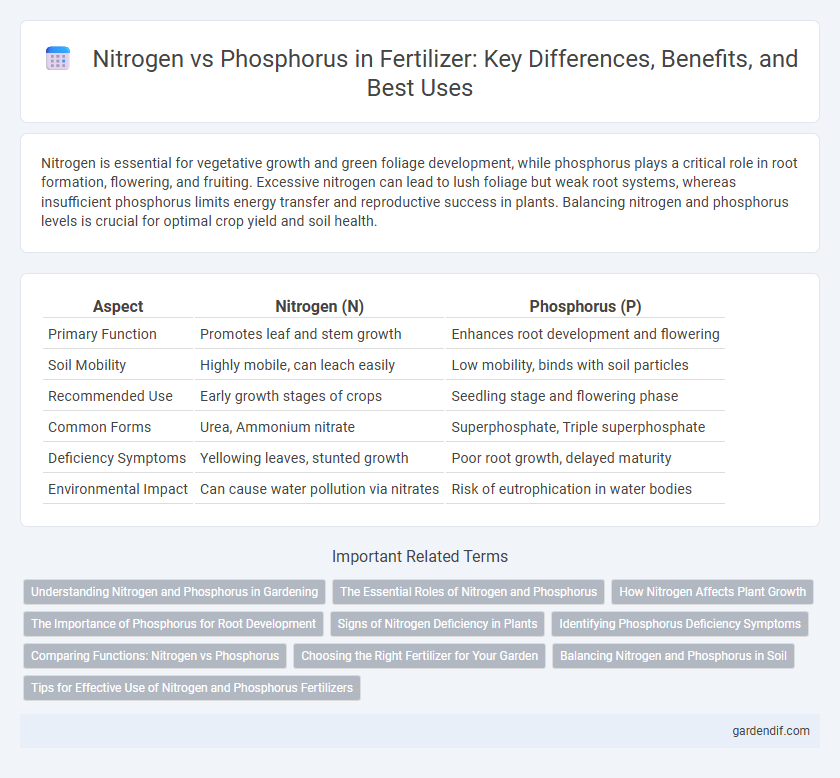
Nitrogen vs Phosphorus Illustration
Nitrogen is essential for vegetative growth and green foliage development, while phosphorus plays a critical role in root formation, flowering, and fruiting. Excessive nitrogen can lead to lush foliage but weak root systems, whereas insufficient phosphorus limits energy transfer and reproductive success in plants. Balancing nitrogen and phosphorus levels is crucial for optimal crop yield and soil health.
Table of Comparison
| Aspect | Nitrogen (N) | Phosphorus (P) |
|---|---|---|
| Primary Function | Promotes leaf and stem growth | Enhances root development and flowering |
| Soil Mobility | Highly mobile, can leach easily | Low mobility, binds with soil particles |
| Recommended Use | Early growth stages of crops | Seedling stage and flowering phase |
| Common Forms | Urea, Ammonium nitrate | Superphosphate, Triple superphosphate |
| Deficiency Symptoms | Yellowing leaves, stunted growth | Poor root growth, delayed maturity |
| Environmental Impact | Can cause water pollution via nitrates | Risk of eutrophication in water bodies |
Understanding Nitrogen and Phosphorus in Gardening
Nitrogen is essential for leafy growth and chlorophyll production, making it a key nutrient for plants needing vigorous foliage development. Phosphorus supports root development, flowering, and fruiting, enhancing overall plant strength and reproductive success. Proper balance of nitrogen and phosphorus is critical for healthy garden plants, ensuring optimal growth and productivity.
The Essential Roles of Nitrogen and Phosphorus
Nitrogen plays a critical role in plant growth by being a fundamental component of amino acids, proteins, and chlorophyll, which are essential for photosynthesis and overall development. Phosphorus is vital for energy transfer within plants, contributing to the formation of ATP and nucleic acids, thereby supporting root development and flowering. Both nutrients are indispensable in fertilizer formulations to ensure balanced crop nutrition and optimize yield.
How Nitrogen Affects Plant Growth
Nitrogen plays a crucial role in plant growth by being a key component of chlorophyll, the molecule responsible for photosynthesis, and amino acids, which are the building blocks of proteins. It promotes vigorous leaf and stem development, enhancing overall plant biomass and green coloration. Unlike phosphorus, which primarily supports root development and energy transfer, nitrogen directly influences vegetative growth and crop yield potential.
The Importance of Phosphorus for Root Development
Phosphorus is essential for promoting strong root development by enhancing energy transfer and cell division within plants, which supports nutrient uptake and overall growth. Unlike nitrogen, which primarily encourages leafy growth, phosphorus contributes to early root formation and improves resilience against environmental stress. Adequate phosphorus availability ensures efficient root architecture, leading to better water absorption and increased crop yields.
Signs of Nitrogen Deficiency in Plants
Nitrogen deficiency in plants is characterized by yellowing leaves, particularly older ones, due to chlorosis caused by impaired chlorophyll production. Growth stunting and reduced leaf size are common symptoms, as nitrogen is essential for amino acid and protein synthesis. Unlike phosphorus deficiency, which primarily affects root development and causes purpling of leaves, nitrogen deficiency directly impacts foliage color and overall plant vigor.
Identifying Phosphorus Deficiency Symptoms
Phosphorus deficiency in plants is identified by stunted growth, dark green or purplish leaves, and delayed maturity, contrasting with nitrogen deficiency symptoms which primarily include yellowing of older leaves. Phosphorus is crucial for root development and energy transfer within the plant, making its deficiency particularly impactful during early growth stages. Recognizing these specific phosphorus deficiency symptoms enables targeted fertilizer application to optimize crop yield and nutrient balance.
Comparing Functions: Nitrogen vs Phosphorus
Nitrogen primarily supports vegetative growth by promoting lush, green foliage and increasing protein synthesis in plants, making it essential during the early growth stages. Phosphorus contributes to root development, energy transfer through ATP, and flower and fruit production, which enhances overall plant maturity and yield. Balancing nitrogen and phosphorus is crucial for optimal crop health, as nitrogen fuels growth while phosphorus strengthens development and reproductive success.
Choosing the Right Fertilizer for Your Garden
Nitrogen is essential for leafy green growth and overall plant vigor, while phosphorus promotes strong root development and flowering. Selecting a fertilizer with a balanced N-P ratio tailored to your garden's specific soil test results enhances nutrient uptake and plant health. For lawns rich in foliage, higher nitrogen content is ideal, whereas phosphorus-rich fertilizers benefit flowering plants and root crops.
Balancing Nitrogen and Phosphorus in Soil
Balancing nitrogen and phosphorus in soil is essential for optimal crop growth, as excessive nitrogen can lead to nutrient imbalances and environmental runoff, while insufficient phosphorus limits root development and energy transfer in plants. Soil testing and precise fertilizer application based on crop nutrient requirements help maintain adequate nitrogen-to-phosphorus ratios, enhancing nutrient use efficiency and minimizing negative ecological impacts. Implementing integrated nutrient management practices supports sustainable soil fertility, ensuring both nitrogen and phosphorus are available in correct proportions for healthy plant development.
Tips for Effective Use of Nitrogen and Phosphorus Fertilizers
Effective use of nitrogen fertilizers involves applying them in split doses to match crop uptake and reduce leaching losses, ensuring maximum nutrient availability and minimizing environmental impact. Phosphorus fertilizers should be placed close to the seed at planting to enhance root access and uptake, especially in soils with low phosphorus availability. Soil testing and precision application techniques optimize the balance between nitrogen and phosphorus, improving crop yield and sustainable nutrient management.
Nitrogen vs Phosphorus Infographic

 gardendif.com
gardendif.com